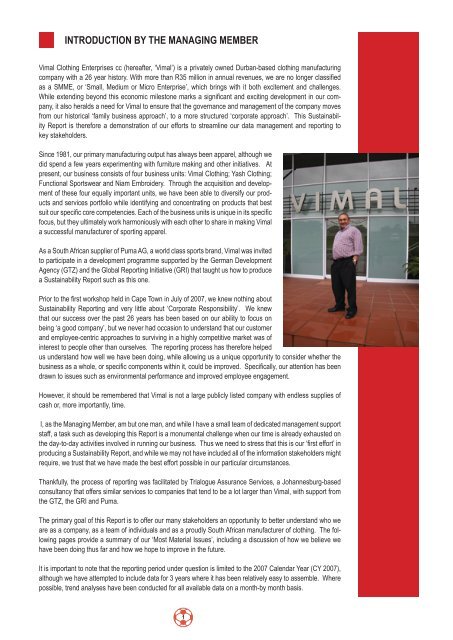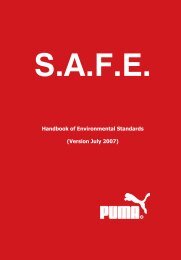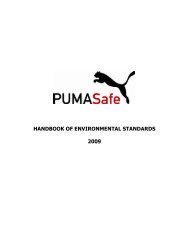Introduction By The Managing Member - Puma
Introduction By The Managing Member - Puma
Introduction By The Managing Member - Puma
Create successful ePaper yourself
Turn your PDF publications into a flip-book with our unique Google optimized e-Paper software.
INTRODUCTION BY THE MANAGING MEMBER<br />
Vimal Clothing Enterprises cc (hereafter, ‘Vimal’) is a privately owned Durban-based clothing manufacturing<br />
company with a 26 year history. With more than R35 million in annual revenues, we are no longer classified<br />
as a SMME, or ‘Small, Medium or Micro Enterprise’, which brings with it both excitement and challenges.<br />
While extending beyond this economic milestone marks a significant and exciting development in our company,<br />
it also heralds a need for Vimal to ensure that the governance and management of the company moves<br />
from our historical ‘family business approach’, to a more structured ‘corporate approach’. This Sustainability<br />
Report is therefore a demonstration of our efforts to streamline our data management and reporting to<br />
key stakeholders.<br />
Since 1981, our primary manufacturing output has always been apparel, although we<br />
did spend a few years experimenting with furniture making and other initiatives. At<br />
present, our business consists of four business units: Vimal Clothing; Yash Clothing;<br />
Functional Sportswear and Niam Embroidery. Through the acquisition and development<br />
of these four equally important units, we have been able to diversify our products<br />
and services portfolio while identifying and concentrating on products that best<br />
suit our specific core competencies. Each of the business units is unique in its specific<br />
focus, but they ultimately work harmoniously with each other to share in making Vimal<br />
a successful manufacturer of sporting apparel.<br />
As a South African supplier of <strong>Puma</strong> AG, a world class sports brand, Vimal was invited<br />
to participate in a development programme supported by the German Development<br />
Agency (GTZ) and the Global Reporting Initiative (GRI) that taught us how to produce<br />
a Sustainability Report such as this one.<br />
Prior to the first workshop held in Cape Town in July of 2007, we knew nothing about<br />
Sustainability Reporting and very little about ‘Corporate Responsibility’. We knew<br />
that our success over the past 26 years has been based on our ability to focus on<br />
being ‘a good company’, but we never had occasion to understand that our customer<br />
and employee-centric approaches to surviving in a highly competitive market was of<br />
interest to people other than ourselves. <strong>The</strong> reporting process has therefore helped<br />
us understand how well we have been doing, while allowing us a unique opportunity to consider whether the<br />
business as a whole, or specific components within it, could be improved. Specifically, our attention has been<br />
drawn to issues such as environmental performance and improved employee engagement.<br />
However, it should be remembered that Vimal is not a large publicly listed company with endless supplies of<br />
cash or, more importantly, time.<br />
I, as the <strong>Managing</strong> <strong>Member</strong>, am but one man, and while I have a small team of dedicated management support<br />
staff, a task such as developing this Report is a monumental challenge when our time is already exhausted on<br />
the day-to-day activities involved in running our business. Thus we need to stress that this is our ‘first effort’ in<br />
producing a Sustainability Report, and while we may not have included all of the information stakeholders might<br />
require, we trust that we have made the best effort possible in our particular circumstances.<br />
Thankfully, the process of reporting was facilitated by Trialogue Assurance Services, a Johannesburg-based<br />
consultancy that offers similar services to companies that tend to be a lot larger than Vimal, with support from<br />
the GTZ, the GRI and <strong>Puma</strong>.<br />
<strong>The</strong> primary goal of this Report is to offer our many stakeholders an opportunity to better understand who we<br />
are as a company, as a team of individuals and as a proudly South African manufacturer of clothing. <strong>The</strong> following<br />
pages provide a summary of our ‘Most Material Issues’, including a discussion of how we believe we<br />
have been doing thus far and how we hope to improve in the future.<br />
It is important to note that the reporting period under question is limited to the 2007 Calendar Year (CY 2007),<br />
although we have attempted to include data for 3 years where it has been relatively easy to assemble. Where<br />
possible, trend analyses have been conducted for all available data on a month-by month basis.<br />
1




